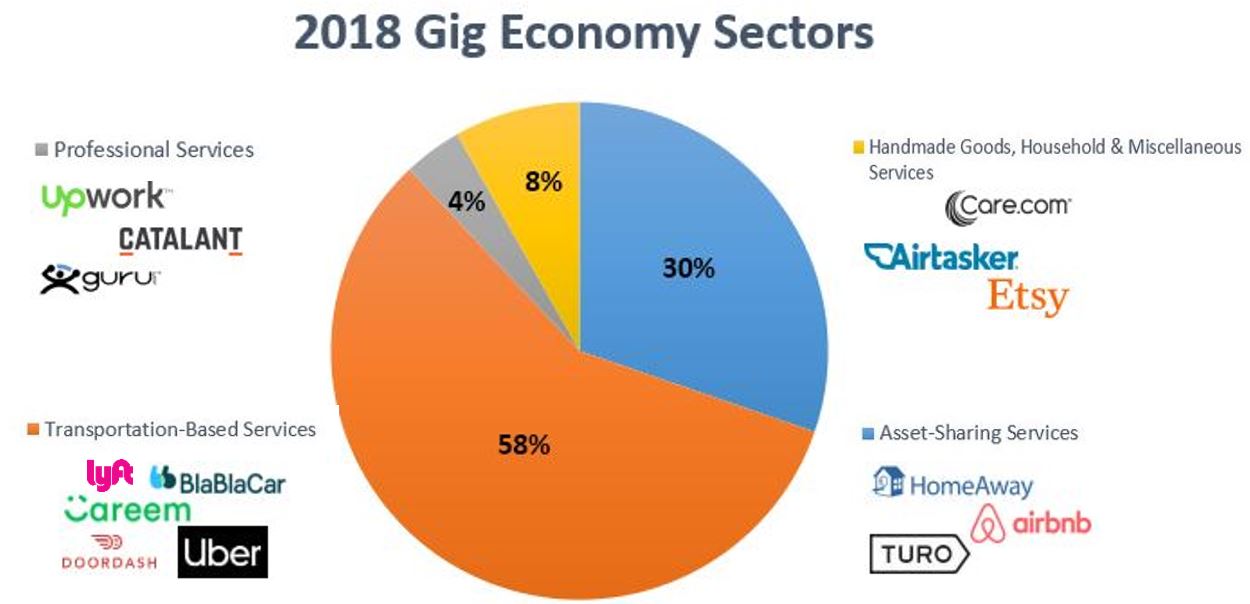eResearch | On September 11, 2019, California passed Assembly Bill 5, legislation that outline the three conditions that must be met to classify a worker as an independent contractor and not an employee. If the worker is reclassified as an employee, the worker has rights to a minimum wage and benefits.
 Companies such as Uber and Lyft work in the “Gig Economy”, a marketplace in which individual workers are paid for short-term engagements and therefore could be affected by the new legislation. Uber’s top lawyer announced in a news conference that Uber’s independent contractors will not be considered employees, as he argued that Uber is a service-based platform with primary goals of connecting consumers and drivers. Nevertheless, Uber and Lyft together proposed a referendum on the bill and put US$90 million aside for lobbying.
Companies such as Uber and Lyft work in the “Gig Economy”, a marketplace in which individual workers are paid for short-term engagements and therefore could be affected by the new legislation. Uber’s top lawyer announced in a news conference that Uber’s independent contractors will not be considered employees, as he argued that Uber is a service-based platform with primary goals of connecting consumers and drivers. Nevertheless, Uber and Lyft together proposed a referendum on the bill and put US$90 million aside for lobbying.
 Assemblywoman Lorena Gonzalez, the Democrat who authored the bill stated that businesses are misclassifying workers for ulterior motives and are negligent of labor rights and obligations including anti-discrimination, health care, pension, worker’s compensation, and unemployment insurance. Regulators want to specifically stop ride-sharing companies, such as Uber and Lyft, from passing their business costs onto taxpayers and workers who are essentially running the companies’ core business operations.
Assemblywoman Lorena Gonzalez, the Democrat who authored the bill stated that businesses are misclassifying workers for ulterior motives and are negligent of labor rights and obligations including anti-discrimination, health care, pension, worker’s compensation, and unemployment insurance. Regulators want to specifically stop ride-sharing companies, such as Uber and Lyft, from passing their business costs onto taxpayers and workers who are essentially running the companies’ core business operations.
Misclassification of workers as independent contractors isn’t something new, as in 2014, FedEx Corporation (NYSE: FDX), a multinational courier delivery company, was labeling its drivers as independent contractors when they were actually working as primary delivery operators, which resulted in a class settlement of US$228 million that was used to resolve claims from over 2,000 drivers.
According to Mastercard and Kaiser Associates, the Gig Economy generated US$204 billion in sales in 2018, which is expected to grow by a 17% CAGR to US$455 billion by 2023. Transportation-based services, such as Uber and Lyft, comprised 58% of the market.

The gig economy is gaining traction because: (1) consumers are more comfortable using peer-to-peer services, (2) online applications through mobile smart phones are easily accessible, (3) some individuals seek flexible work-life environments, and (4) the rising cost of living is forcing people to look for additional income.
 A company that is taking advantage of the gig economy market who recently underwent an IPO is Fiverr International Ltd. (NYSE: FVRR), a marketplace platform that connects freelancers with customers per need-based projects. In June 2019, Fiverr priced its IPO at US$21 per share in an effort to raise US$110 million at a target valuation of US$650 million. Though Fiverr reported an impressive 45% growth in revenue to US$75.5 million in 2018, the company widened its losses to US$36.1 million compared with a loss of US$19.3 million year-over-year.
A company that is taking advantage of the gig economy market who recently underwent an IPO is Fiverr International Ltd. (NYSE: FVRR), a marketplace platform that connects freelancers with customers per need-based projects. In June 2019, Fiverr priced its IPO at US$21 per share in an effort to raise US$110 million at a target valuation of US$650 million. Though Fiverr reported an impressive 45% growth in revenue to US$75.5 million in 2018, the company widened its losses to US$36.1 million compared with a loss of US$19.3 million year-over-year.
Similar to Fiverr, the majority of gig economy companies are struggling to turn a profit, including Uber and Lyft, who reported significant losses of US$5.2 billion and US$644.2 million in Q2/2019 earnings, respectively. Gig economy companies are constantly reporting losses due to (1) poor monetization of core business, (2) significant investments in marketing and providing discounts to increase market share, (3) ongoing legal cases leading to higher expenses, and (4) a highly competitive landscape.
As California implements the new law and gig economy companies argue that their businesses are in-line with new regulations, it will be interesting to see how these companies defend their business models and classification of workers.
//
Uber Technologies Inc. (NYSE: UBER; LSE: 0A1U; DB: UT8)
- Headquartered in California, United States, Uber is a multinational peer to peer transportation platform and network, which include ride sharing, ride service hailing, food delivery, and bicycle sharing.
- Uber listed as a public company and started trading on the New York Stock Exchange in May 2019.
- Uber is currently trading at US$34.20 per share with a market capitalization of US$58.1 billion.
Lyft Inc. (NASDAQ: LYFT; DB: LY0)
- Headquartered in California, United States, Lyft is a peer-to-peer ridesharing company that operates in the United States and Canada.
- Lyft listed as a public company and started trading on the NASDAQ in March 2019.
- Lyft is currently trading at US$46.86 with a market capitalization of US$13.7 billion.
Fiverr International Ltd. (NYSE: FVRR)
- Headquartered in Tel Aviv, Israel, Fiverr is an online platform that connects freelancers with customers for offerings of small services such as web development and logo design.
- Fiverr listed as a public company and started trading on the NYSE in June 2019.
- Fiverr is currently trading at US$19.53 with a market capitalization of US$599.7 million.
//




